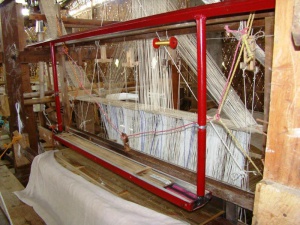Name : Deepak Bharali
District & State : Kamrup, Assam
Category : Engineering
Award : State
Award Function : 5th National Grassroots Innovation Awards
Award Year : 2009
Price : Rs. 6000/- (ex-factory price + packaging). The price does not include transportation costs, taxes, etc.
Delivery Period : Regular order – One week, for bulk order (2000 units) – A Month
Innovation Description
- Award Status
- IPR Status
- Technical Specification
- Salient Features
 Conventionally the task of the insertion of weft threads to make a variety of designs is done manually by tying knots. It is tedious, cumbersome and time consuming. The thread is also wasted in the connection between one motif and another. Deepak has come up with a device consisting of three components; base frame, magnet-bearing shaft and specially designed bobbin. These components can be fitted to any handloom Jacquard machine. The innovation reduces the time required for making designs to one third of what is required in the traditional way of doing it.
Conventionally the task of the insertion of weft threads to make a variety of designs is done manually by tying knots. It is tedious, cumbersome and time consuming. The thread is also wasted in the connection between one motif and another. Deepak has come up with a device consisting of three components; base frame, magnet-bearing shaft and specially designed bobbin. These components can be fitted to any handloom Jacquard machine. The innovation reduces the time required for making designs to one third of what is required in the traditional way of doing it.
Background
Deepak Bharali (33 years) hails from Napara in Sualkuchi in Kamrup district of Assam. The village, also locally known as the “Manchester of the East”, is situated at a distance of 35 kms from Guwahati along the banks of the river Brahmaputra. The economy of the area is mainly dependent on weaving of muga silk using traditional looms.
Deepak is the seventh child of his parents. His family hails from Sualkuchi and has been engaged in production and trading of silk goods. His father, Late Haren Bharali, was a distributor of silk items. His mother expired when he was six years old. His father died while he was doing his graduation. Since then, he has been the breadwinner and has continued the family business. He makes a living by producing and selling muga silk using his looms.
Even as a young child, Deepak had a keen eye for detail. One day, while pulling out an old cycle tyre from a ditch, he observed that the inner sides of the tyre were lined with different types of small fish. As an experiment, he put another tyre into the ditch and noticed that after few hours, this tyre too was filled with lots of fish. Since then, this had become his unique technique for catching fish. Continuing further, he noticed that he could also use a bamboo cylinder to catch the fishes. Using every available object, even discarded bearings, he has built model cars.
After completing his graduation, Deepak looked for jobs and applied for various posts in both State and Central government departments. Later on, he decided to pursue his family business. He started with his first loom in 1998, for weaving plain cloth shorn of any design or ornamentation. Using the looms himself, he wove the cloth and learnt about various aspects of production. After nine months, he installed his second loom and diversified into producing silk with designs. Here he ran into heavy weather as he tried to increase production by adding more looms, and hiring skilled but expensive workers. The slow speed and limitations of traditional silk producing methods added to his troubles. He circumvented this by innovating and developing a new accessory for the Jacquard loom which could ensure nine fold reduction in time, simplify work and lead to better utilization of looms per day. Secondly, it might become possible to hire unskilled workers as well.
Deepak appreciates the support received from family members in developing new tools and devices for silk production. His wife helps him in production work such as cutting and sanding. His brothers often help him in marketing the raw materials and tools. Many of his friends and members of local community are impressed by his innovation and think it is nothing short of magic in the world of weaving.
He is a role model in his locality and for all neighboring loom owners as he had started out from his home with one loom and now he runs 19 looms successfully.
Genesis of innovation
Over the years, the weavers faced common problems while working with the Jacquard looms. Firstly, the handling of weft threads at various intervals and the tying of knots caused drudgery and required a lot of time and effort. An average fabric, consisting of 30 rows of lines with 14 designs in a row, would have at least 3 knots per design. This would mean a total of 1260 knots and that would require almost 10 hours, assuming the weaver takes 30 seconds to make each knot. Secondly, working on designs that need simultaneous handling of five or more threads requires great skill that only a few skilled weavers possess. Thirdly, while handling broad designs or when the gap between the weft threads is too small, the weavers find it difficult to slide their finger in to handle the wefts. To increase production speeds, automate and cut down the repetitive process in routine tasks, Deepak decided to create a dedicated fixture style attachment that can be fitted into the standard Jacquard loom.
Product Details
The design making device is an attachment which can be fitted into any Jacquard loom. The device has three components; a base frame which acts as a shaft holder, the magnet bearing shaft and the specially designed bobbin. The uniqueness lies in using the magnetic clamping systems and specially designed bobbin to achieve its efficacy.
The attachment facilitates the Jacquard loom to do automatic selection and lifting of warp threads for design making. The magnet fitted shaft is fitted into the base frame. The number of magnets will vary upon the number of designs that one has in each line. Unlike normal design-making loom where each weft thread is connected to a bobbin, these bobbins are placed on the lower surface of the base frame, just on top of the corresponding magnets fixed on the shaft.
Once the magnet sensitive bobbins are glued to the surface, the frame is taken on top of the warp threads. As the Jacquard machine selects and lifts the warp threads, the device is placed on top of the warp threads. The device is placed in such a way that the bobbin’s attached surface faces downwards and each bobbin falls in between two sets of lifted warp threads.
As the magnet fitted shaft moves from one side to the other, it also drags along the bobbins attached to it from one side to other. In the process, the simultaneous crossing of all weft threads for design making takes place. Once the weft-thread bobbins are crossed, the whole device is lifted to continue with the normal loom weaving process. The same process is continued for all the weft thread configurations till the design making is completed.
The prior art search in both the patent and non-patent databases shows the existence of a number of handlooms which require the design to be threaded manually, which is extremely time consuming and requires a lot of effort as well as skill. US patent 4581905 (15/04/1986) reveals a process and a knitting machine to produce figured fabrics. WO/2006/027240 (Pub. Date 16/03/2006) discloses a gripper device for weft threads for a loom in which the gripping force can be changed during weaving according to the pattern of the material to be produced. However, prior art search does not indicate a similar device in handloom fabric weaving.
Product application and dispersion
The attachment of this fixture to the Jacquard loom achieves increased productivity, ease of use and better fabric quality. It also facilitates automatic selection and lifting of warp threads to handle elaborate fabric designs.
The innovation facilitates a productivity boost of over 60% while eliminating the drudgery. This attachment to the Jacquard loom allows unskilled workers to enter the industry and produce elaborately designed fabrics.
Using locally available components, and low cost, this attachment could deliver a lifetime value for thousands of handloom units by achieving better utilization of loom and time spent by workers.
Till now, Deepak has set up the preliminary device in his ten looms. In the next step, he wishes to extend it to another nine looms with the refined model. If he becomes successful he will start the business by selling the device first in his village, then in Assam, India and aboard.
IIT Guwahati, has been guiding the design process lately. Despite numerous iterations, the final design has not yet been fabricated successfully in Guwahati. A firm has been contacted in Delhi to get casing for magnetic bobbins designed and fabricated in plastic properly.
Deepak also has a dream to make modifications in the power looms. Generally, in power looms the insertion of extra weft is done by using shuttle and then cutting the unused portion. Such cloth normally looses its demand in the market. He wants to study the working of power loom so that his device can be installed there. The innovator has been extended venture finance from MVIF at NIF and also product development support for technical improvements in his innovation.
